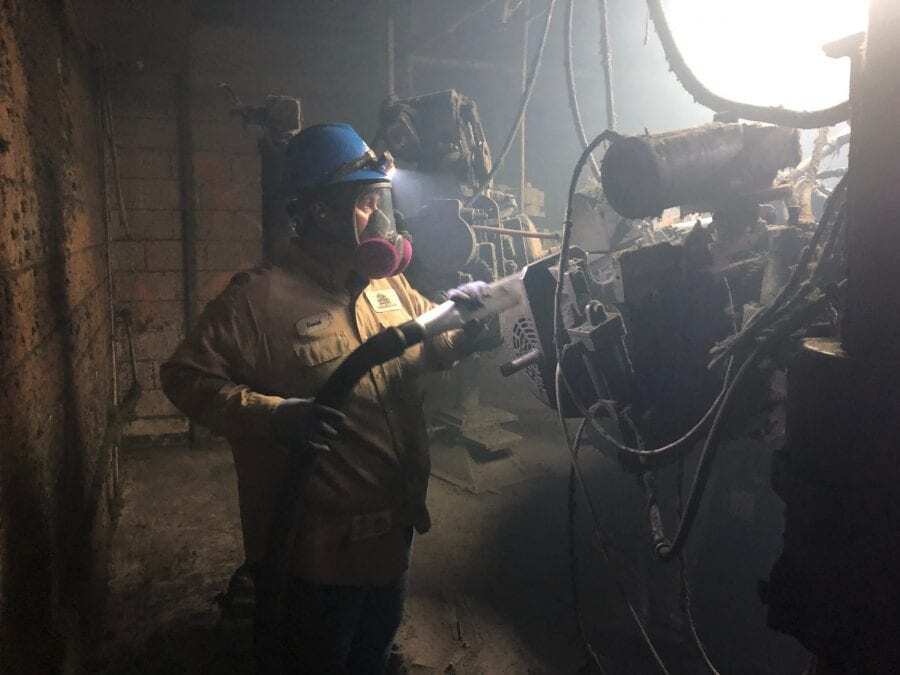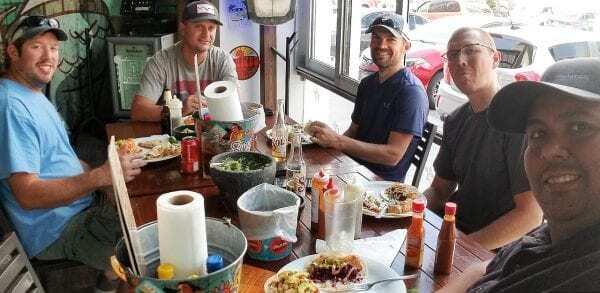Two separate Environmental Works, Inc. field services teams recently wrapped up international projects in two vastly different locales. A crew of five field services project managers, supervisors and technicians from EWI’s Springfield, Missouri, and Springdale, Arkansas, offices toughed out the dusty, dry, high desert weather in Chihuahua, Mexico, while a team of five field services project managers, inspectors and technicians from EWI’s Kansas City office bundled up and braved the bitterly cold weather in Greenland. Both projects were completed on time and well within scope.
 The Chihuahua, Mexico, crew – which included Operations Manager Greg Eichmeyer, Project Manager Lucas Still, and field services supervisors David Gonzales, William Walker and Chad Hathaway – spent a week cleaning combustible dust at a large industrial facility. They overcame odd hours and little sleep, mostly working overnights, to complete the tasks on schedule and the project on time. The thrust of the trip was to demonstrate to and train the plant employees on how to effectively and safely clean the facility with new equipment provided by EWI.
The Chihuahua, Mexico, crew – which included Operations Manager Greg Eichmeyer, Project Manager Lucas Still, and field services supervisors David Gonzales, William Walker and Chad Hathaway – spent a week cleaning combustible dust at a large industrial facility. They overcame odd hours and little sleep, mostly working overnights, to complete the tasks on schedule and the project on time. The thrust of the trip was to demonstrate to and train the plant employees on how to effectively and safely clean the facility with new equipment provided by EWI.
 The client and its management staff were impressed with the results, said Eichmeyer, adding that there are at least two additional trips planned through the end of the year.
The client and its management staff were impressed with the results, said Eichmeyer, adding that there are at least two additional trips planned through the end of the year.
“All of EWI’s crew members represented the company to the highest standards and really showed what GSD looks like,” he said. “David (Gonzales) was especially beneficial to the success of the project as he performed a dual role of technician and translator, which eliminated the communication barrier.”
While the Chihuahua, Mexico, crew was cleaning the dust off their clothes, the Greenland, team – which included Operations Manager Paul Ballance, Inspector Barry Hamilton, Field Supervisor Josh Tomassie, and field technicians Kyle Resseguie and Dylan Blank – was emptying, opening, cleaning, inspecting and putting 13 JP8 fuel tanks back into service at a United States Air Force Base. The 25,000 gallon tanks are used to fuel the flight line and vehicles on the base. JP8 is a military aviation fuel that doesn’t gel and has extra additives to prevent corrosion and biological contamination.
 “Most of the tanks could not be completely emptied, so we opened them up and used a diaphragm pump to pump the remainder of the clean JP8 (fuel) into a tanker truck, then pumped the dirty fuel, which had a small bit of water in it, into a tote,” said Hamilton. “Then one of the field technicians would go in to the tank to squeegee the last bit of fuel into the pump hose, and the tanks were wiped down with mats.”
“Most of the tanks could not be completely emptied, so we opened them up and used a diaphragm pump to pump the remainder of the clean JP8 (fuel) into a tanker truck, then pumped the dirty fuel, which had a small bit of water in it, into a tote,” said Hamilton. “Then one of the field technicians would go in to the tank to squeegee the last bit of fuel into the pump hose, and the tanks were wiped down with mats.”
The team was on site for 16 days, which gave them a little bit of down time to explore the Arctic terrain.
“We had time to take a couple of tours,” said Hamilton. “We saw glaciers, icebergs, musk ox, seals, tiny little foxes, and huge rabbits. Rock collecting is a big deal up here because of the glaciers and the guys found some very cool quartz to bring back.”
Of course, the weather didn’t always cooperate, and only added to the challenge of cleaning the tanks.
“It was between 40-50 degrees every day. However, there were three glaciers close by and when the wind blew, which it seemed to do a lot, it got really cold,” said Hamilton. “It rained at least four of the days we were there and it was the coldest rain I’ve ever felt. Oh, and I almost forgot to mention that it doesn’t get dark there this time of year – 24 hours of sunlight.”



